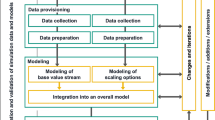Abstract
The increasing attention to customer demands in the product process, and the inevitable features and costs of production processes have led researchers and artisans to manage orders and choose the right policy for production planning. This article identifies the structure for determining the optimal location of the Customer Order Decoupling Point (CODP) and the optimal production planning policy as one of the most important strategic decisions in the production process. So, we developed a discrete-event simulation model for realistic calculation of cost and flow time, under different scenarios, and we used the production and sales information of a dairy production plant for validation and implementation of the model. The results suggest that the use of a hybrid production planning policy reduces the cost and delivery time.












Similar content being viewed by others
References
Aouam T, Geryl K, Kumar K, Brahimi N (2017) Production planning with order acceptance and demand uncertainty. Comput Oper Res 91:145–159
Aouam T, Brahimi N (2013) Integrated production planning and order acceptance under uncertainty: a robust optimization approach. Eur J Oper Res 228:504–515
Atan Z, Ahmadi T, Stegehuis C, DeKok T, Adan L (2017) Assemble-to-order systems: a review. Eur J Oper Res 261(3):866–879
Dellaert NP, Melo MT (1996) Production strategies for a stochastic lot sizing problem with constant capacity. Eur J Oper Res 92:281–301
Diaz JE, Handl J, Xu DL (2018) Integrating meta-heuristics, simulation and exact techniques for production planning of a failure-prone manufacturing system. Eur J Oper Res 266(3):976–989
Gargouri E, Hammadi S, Borne P (2002) A study of scheduling problem in agro-food. Manufacturing systems. Math Comput Simul 60:277–291
Garn W, Aitken J (2015) Splitting hybrid make-to-order and make-to-stock demand profiles. arXiv preprint arXiv:1504.03594, 15
Gupta D, Benjaafar S (2004) Make-to-order, make-to-stock, or delay product differentiation? A common framework for modeling and analysis. IIE Trans 36(6):529–546
Kober J, Heinecke G (2012) Hybrid production strategy between make-to-order and make-to-stock, a case study at a manufacturer of agricultural machinery with volatile and seasonal demand. In: 45th CIRP Conference on manufacturing systems, 2012, 453–458
Lattanzio T, Cauvin A (2006) Decisional modelling for engineer-to-order. IFAC Proceedings Volumes, 39:3, 793–798
Makris S, Zoupas P, Chryssolouris G (2011) Supply chain control logic for enabling adaptability under uncertainty. Int J Product Res 49:121–137
Motallebi S, Zandieh M (2017) Determination of inventory management policies in process manufacturing: using discrete-event-simulation. J Ind Manag Perspect 26:83–108
Olhager J (2003) Strategic positioning of order penetration point. Int J Prod Econ 85:319–329
Rodgers P, Nandy A (2007) Judicious order acceptance and order release in make-to-order manufacturing systems. Product Plan Control 18(7):610–625
Sharda B, Akiya N (2012) Selecting make-to-stock and postponement policies for different products in a chemical plant: a case study using discrete-event-simulation. Int J Product Econ 136:161–171
Soman CA, VanDonk DP, Gaalman G (2004) Combined make-to-order and make-to-stock in a food production system. Int J Prod Econ 90(2):223–235
Soman CA, VanDonk DP, Gaalman GJC (2006) Comparison of dynamic scheduling policies for hybrid make-to-order and make-to-stock production systems with stochastic demand. Int J Prod Econ 104:441–453
Su JCP, Chang Y, Ferguson L, M (2005) Evaluation of postponement structures to accommodate mass customization. J Oper Manag 23:305–318
VanDonk DP (2001) Make to stock or make to order: the decoupling point in the food processing industries. Int J Prod Econ 69(2):297–306
Wikner J, Rudberg M (2005) Integrating production and engineering perspectives on the customer order decoupling point. Product Eng Perspect 25(7):623–641
Author information
Authors and Affiliations
Corresponding author
Rights and permissions
About this article
Cite this article
Zandieh, M., Motallebi, S. Determination of production planning policies for different products in process industries: using discrete event simulation. Prod. Eng. Res. Devel. 12, 737–746 (2018). https://doi.org/10.1007/s11740-018-0843-y
Received:
Accepted:
Published:
Issue Date:
DOI: https://doi.org/10.1007/s11740-018-0843-y




